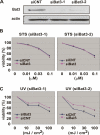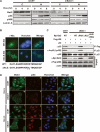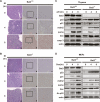HLA-B-associated transcript 3 (Bat3)/Scythe is essential for p300-mediated acetylation of p53
- PMID: 17403783
- PMCID: PMC1838535
- DOI: 10.1101/gad.1534107
HLA-B-associated transcript 3 (Bat3)/Scythe is essential for p300-mediated acetylation of p53
Abstract
In response to DNA damage, p53 undergoes post-translational modifications (including acetylation) that are critical for its transcriptional activity. However, the mechanism by which p53 acetylation is regulated is still unclear. Here, we describe an essential role for HLA-B-associated transcript 3 (Bat3)/Scythe in controlling the acetylation of p53 required for DNA damage responses. Depletion of Bat3 from human and mouse cells markedly impairs p53-mediated transactivation of its target genes Puma and p21. Although DNA damage-induced phosphorylation, stabilization, and nuclear accumulation of p53 are not significantly affected by Bat3 depletion, p53 acetylation is almost completely abolished. Bat3 forms a complex with p300, and an increased amount of Bat3 enhances the recruitment of p53 to p300 and facilitates subsequent p53 acetylation. In contrast, Bat3-depleted cells show reduced p53-p300 complex formation and decreased p53 acetylation. Furthermore, consistent with our in vitro findings, thymocytes from Bat3-deficient mice exhibit reduced induction of puma and p21, and are resistant to DNA damage-induced apoptosis in vivo. Our data indicate that Bat3 is a novel and essential regulator of p53-mediated responses to genotoxic stress, and that Bat3 controls DNA damage-induced acetylation of p53.
Figures







Similar articles
-
E6 oncoprotein represses p53-dependent gene activation via inhibition of protein acetylation independently of inducing p53 degradation.Mol Cell. 2005 Jan 21;17(2):251-64. doi: 10.1016/j.molcel.2004.12.016. Mol Cell. 2005. PMID: 15664194
-
HIPK2 contributes to PCAF-mediated p53 acetylation and selective transactivation of p21Waf1 after nonapoptotic DNA damage.Oncogene. 2005 Aug 18;24(35):5431-42. doi: 10.1038/sj.onc.1208717. Oncogene. 2005. PMID: 15897882
-
DNA damage activates p53 through a phosphorylation-acetylation cascade.Genes Dev. 1998 Sep 15;12(18):2831-41. doi: 10.1101/gad.12.18.2831. Genes Dev. 1998. PMID: 9744860 Free PMC article.
-
To die or not to die: a HAT trick.Mol Cell. 2006 Dec 28;24(6):807-8. doi: 10.1016/j.molcel.2006.12.005. Mol Cell. 2006. PMID: 17189182 Review.
-
The impact of acetylation and deacetylation on the p53 pathway.Protein Cell. 2011 Jun;2(6):456-62. doi: 10.1007/s13238-011-1063-9. Epub 2011 Jul 12. Protein Cell. 2011. PMID: 21748595 Free PMC article. Review.
Cited by
-
Candidate variants at 6p21.33 and 6p22.1 and risk of non-small cell lung cancer in a Chinese population.Int J Mol Epidemiol Genet. 2010;1(1):11-8. Epub 2009 Jul 26. Int J Mol Epidemiol Genet. 2010. PMID: 21537448 Free PMC article.
-
Novel interaction between proliferating cell nuclear antigen and HLA I on the surface of tumor cells inhibits NK cell function through NKp44.PLoS One. 2013;8(3):e59552. doi: 10.1371/journal.pone.0059552. Epub 2013 Mar 19. PLoS One. 2013. PMID: 23527218 Free PMC article.
-
HLA-B-associated transcript 3 (Bat3) stabilizes and activates p53 in a HAUSP-dependent manner.J Mol Cell Biol. 2020 Feb 20;12(2):99-112. doi: 10.1093/jmcb/mjz102. J Mol Cell Biol. 2020. PMID: 31647545 Free PMC article.
-
p85α mediates p53 K370 acetylation by p300 and regulates its promoter-specific transactivity in the cellular UVB response.Oncogene. 2011 Mar 17;30(11):1360-71. doi: 10.1038/onc.2010.506. Epub 2010 Nov 8. Oncogene. 2011. PMID: 21057544 Free PMC article.
-
Titanium Dioxide Nanoparticles Alter the Cellular Phosphoproteome in A549 Cells.Nanomaterials (Basel). 2020 Jan 21;10(2):185. doi: 10.3390/nano10020185. Nanomaterials (Basel). 2020. PMID: 31973118 Free PMC article.
References
-
- Ahn J., Prives C., Prives C. The C-terminus of p53: The more you learn the less you know. Nat. Struct. Biol. 2001;8:730–732. - PubMed
-
- Appella E., Anderson C.W., Anderson C.W. Post-translational modifications and activation of p53 by genotoxic stresses. Eur. J. Biochem. 2001;268:2764–2772. - PubMed
-
- Avantaggiati M.L., Ogryzko V., Gardner K., Giordano A., Levine A.S., Kelly K., Ogryzko V., Gardner K., Giordano A., Levine A.S., Kelly K., Gardner K., Giordano A., Levine A.S., Kelly K., Giordano A., Levine A.S., Kelly K., Levine A.S., Kelly K., Kelly K. Recruitment of p300/CBP in p53-dependent signal pathways. Cell. 1997;89:1175–1184. - PubMed
-
- Ayed A., Mulder F.A., Yi G.S., Lu Y., Kay L.E., Arrowsmith C.H., Mulder F.A., Yi G.S., Lu Y., Kay L.E., Arrowsmith C.H., Yi G.S., Lu Y., Kay L.E., Arrowsmith C.H., Lu Y., Kay L.E., Arrowsmith C.H., Kay L.E., Arrowsmith C.H., Arrowsmith C.H. Latent and active p53 are identical in conformation. Nat. Struct. Biol. 2001;8:756–760. - PubMed
Publication types
MeSH terms
Substances
Grants and funding
LinkOut - more resources
Full Text Sources
Other Literature Sources
Molecular Biology Databases
Research Materials
Miscellaneous
